How do feminist artists use art and photography to display messages to society?
“I wanted to foreground girls’ lives, centring them by creating an all-female society.” – Justine Kurland – 25th January 2023
The works of Justine Kurland express the heritage of youth, girlhood and a search for identity, capturing the lives of young teenage runaways specifically through her book, Girl Pictures. Girl Pictures is a photo book, presenting an enduring symbol of romance, rebellion, escape, and freedom through the representation of teenage runaways, which ultimately challenges traditional narratives of femininity. Created between 1997 and 2002, Kurland focused on the roads in the American wilderness, and her subjects are presented as companies to one another, promoting a strong sense of intimacy throughout her series. My personal study will take inspiration from her photo book, as I feel it resonates deeply with my ideas and what I want to portray. Her work evokes a strong sense of nostalgia and longing for freedom, and her images blend the innocence of girlhood with the strength and independence young women find during adolescence. The contrast of the two allow Kurland to construct a powerful narrative about the importance of connection and community during this time, which encourages girls like myself to delve into our own experiences including vulnerability and strength. Kurland’s work stands out to me because her subjects experiment with intimacy and protection, along with the experimentation of nostalgia to evoke a sense of freedom, rebellion and escape. These ideas successfully link to my project as I am aiming to reflect these themes through my own personal experiences as growing up as a girl in the island of Jersey. Family Album by Ramona Jingru Wang carefully investigates themes of identity and relationships, similar to Kurland. Wang shed light on the exploitations of models, and her work is a quiet refusal of specific representations of them. Wang’s images in this series depict her family, where she delves into the themes of identity and the connections between humans and the space around us, through capturing simple everyday moments that highlight femininity and nurture. I took inspiration from Wang due to her ability to shift certain stereotypes and present young women in a way that feels empowering to viewers like myself. I admire her unique approaches to photographing young girls, and this allows me to consider how I can use these ideas to portray my own experiences as growing up as a girl. Both Kurland and Wang stand out to me through their ability to challenge traditional female stereotypes and capture femininity and youth from a female perspective, making it easier for me to feel inspired by their work, understand their values and successfully incorporate them into my personal project.
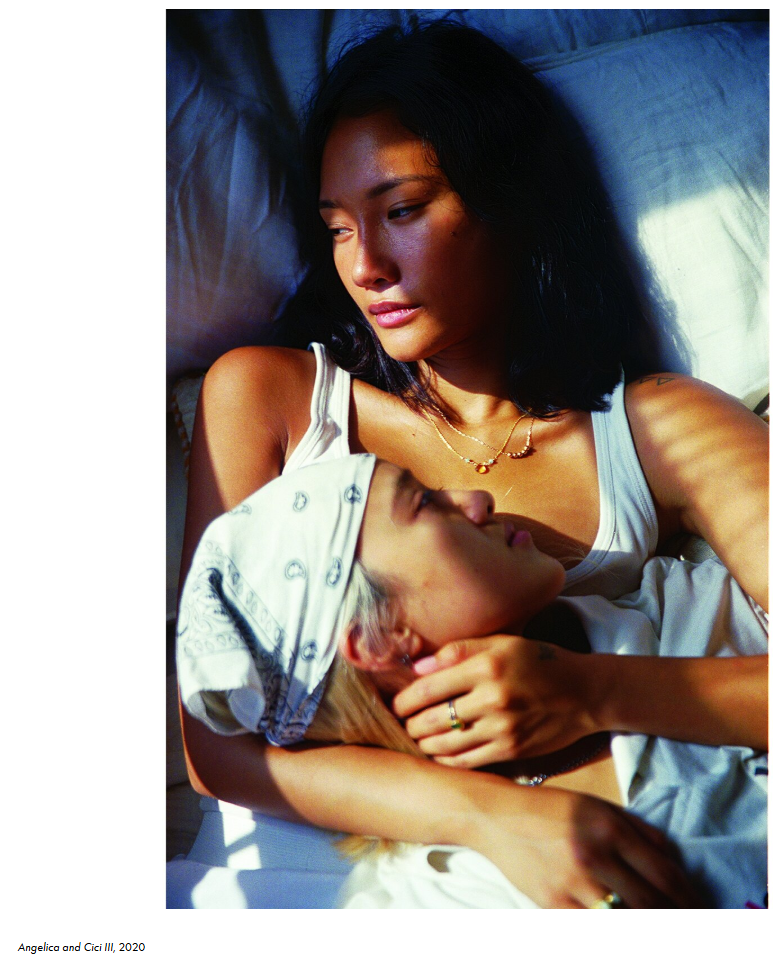
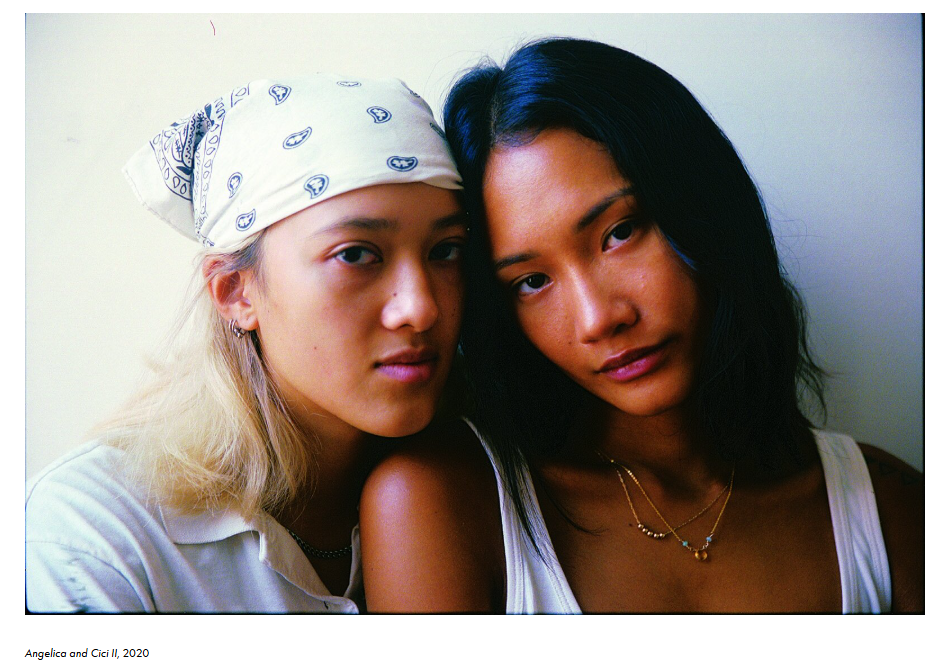
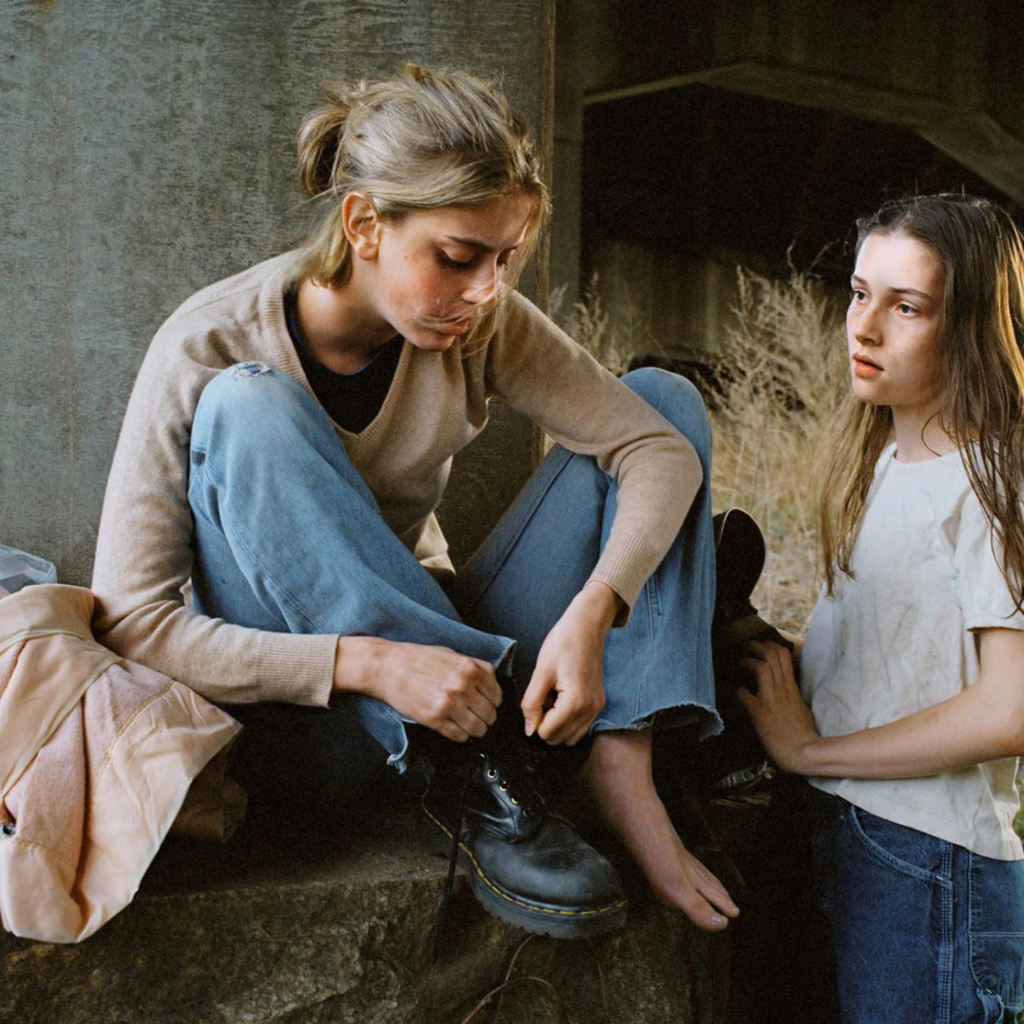
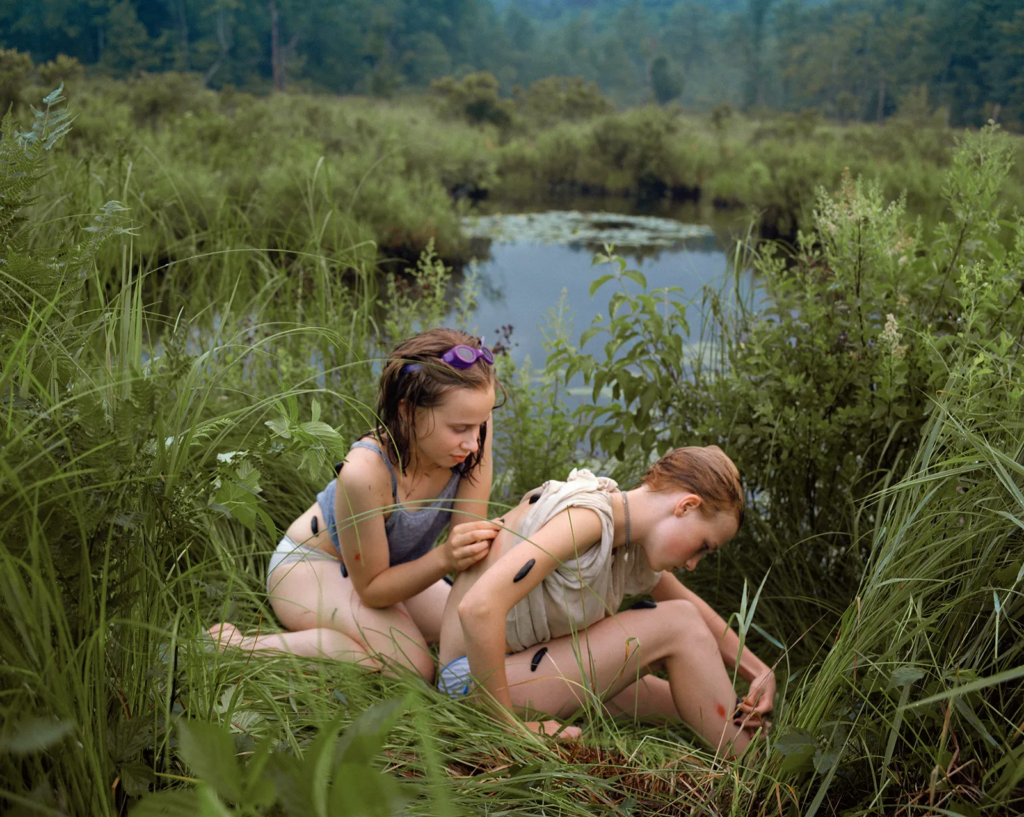
The Male Gaze
I am basing my personal study project on the themes of youth and femininity as I feel passionately towards both topics. Femininity is significant to me as I am a young female who feels the need to carry out certain feminine qualities in order to display my place in social circles, as well as society as a whole. The male gaze is a term formulated by feminist theorist Laura Mullvey in 19th and 20th century. She introduced the concept in 1975, where she argued that the mainstream media constructs women into objects of male desire. The link below shows the psychoanalytic and feminist theory by Jacques Lacan and Luce Irigaray, in Mullvey’s Visual Pleasure and Narrative Cinema essay. I have read through the pages and deepened my understanding of the voyeuristic values that society have shaped around women and how long these values have been around, as well as where they have stemmed from.
https://www.columbia.edu/itc/architecture/ockman/pdfs/feminism/mulvey.pdf.
After reading through the pages of Lacan’s and Irigaray’s views, I found myself most drawn to page 21, specifically the quote:
“Ultimately, the meaning of women is sexual difference, the visually ascertainable absence of the penis, the material evidence on which is based the castration complex essential for the organisation of entrance to the symbolic order and the law of the father”.
This quote tells me that power is determined by gender, ie. males with a penis holds more power, whereas castrated women are immediately frowned upon as it is assumed that they lack intelligence. It also exhibits the idea that females are judged by what they lack rather than the qualities they do have, which follows the traditional stereotypes. Therefore, this plays a key part in the development of gender identity and is perhaps the reason many women struggle with becoming at ease with their identity. Most art and photography projects that include women also follow the idea that women exist primarily to be looked at, and are only framed in a way that emphasizes their beauty or vulnerability, reinforcing male control. I believe that my artist Ramona Wang has included aspects of the male gaze into her work and perhaps taken inspiration from it to challenge stereotypes of women. For example, Wang uses the ‘camera’s gaze’ approach in a lot of her images, in which her subjects are looking seductively at the camera or posed in submissive ways. I believe that this approach to her photographs is to challenge traditional stereotypes of depicting women for male pleasure, as she has used her subjects to mimic the poses from photography and film, therefore exposing how women are forced to perform femininity. Contrastingly, Justine Kurland does not use the male gaze in her photography. Rather, her work rejects the idea, particularly in her Girl Pictures series that I am focusing on. Her work challenges traditional depictions of females in photography, as she has her subjects appear more free and powerful instead of weak and vulnerable, which is how women are often portrayed in art, photography and media. Femininity is a mixture of qualities and characteristics that exhibit narratives that only women can do, which therefore ultimately separates us from men. Despite this, feminism in general is seen as a movement to end sexism, which I also think plays a vital role in my project as women have faced many battles with sexism, and fought for values to be modernised in a way that allows an equal balance between genders. The girls in Girl Pictures are often presented as dirty, tough and portraying a tomboyish look, which goes against the idea that youth and femininity must be delicate. I aim to touch on these conventions in my project due to the natural ingrained stereotypes of females, and therefore shine light on the inequalities. These values of mine have guided me to focus my project on femininity, as I feel it allows people to find their personal identity and can help us explore how femininity is expressed through different generations and cultures. Youth is equally as important to me as I aim to successfully highlight the impact youth has on an individual, through being able to develop their skills and also finding their own personality that they feel they can express to the world. I think my two themes link effectively to one another because they are both mainly shaped by societal factors. In my opinion, society idolises youth and associates it with beauty which then creates pressure for young females to adopt these elements into their identity.
I will be responding to these two artists by taking in all of my inspiration from them and capturing several photoshoots that portray similar ideas to them both. For example, my first photoshoot will take place outdoors in a natural and rural landscape, similar to Justine Kurland. This is because she focused on photographing a fantasy and utopian world that teenage girls ran away from home to live in. I will recreate this idea using my friends as subjects, and the location of my shoot will be St Catherine’s woods where my subjects can explore the nature surrounding them. My second photoshoot will primarily take inspiration from Ramona Wang, located indoors. This is due to the fact Wang mainly captured her subjects indoors with minimal clothing and expressing a traditional exploitation of females, specifically her loved ones. My photoshoot will include aspects of the male gaze, as this is another significant factor that contributes to my project and the themes of youth and femininity. My third photoshoot will be another inspired by Kurland, where I will take my subjects into more scenes of nature where they can display the ‘runaway’ narrative and build relationships with one another in the wild. My fourth photoshoot will be one with no particular artist inspiration, an opportunity for me to incorporate my own ideas and imagination tied into youth and femininity. It will be shot outdoors similar to my first photoshoot to stay related to my main artist Justine Kurland, yet I aim to include exploitations of females to stick to my themes. My last photoshoot will be mainly inspired by Wang again, where I will be the main subject presenting female stereotypes. This is because I feel strongly about the topic, and by including myself I am able to present my values and beliefs in my project to add a more realistic effect. I will include images of me doing things that typical young women do, for example putting on makeup and dressing up to go out.
Justine Kurland
Justine Kurland uses her photography to challenge the traditional stereotypes shaped around women. She uses her platform to reinforce the idea that women do not have to perform in certain ways and exhibit specific behaviours in order to be feminine. In Girl Pictures, Kurland reimagines her models as independent, free and brave, which are characteristics that women are not usually seen to have. Due to mainstream media, male-dominated traditions have formed gender inequalities, leading to an uneven balance between men and women. I feel drawn to the idea that Kurland has focused her work mainly around young women, and has placed them in the centre rather than outside objects of desire for men to view. I believe that she has successfully criticised the expectations imposed on young women in most mainstream narratives, and suggested an alternative vision of female dominance which is very important for young girls to see. My overall aim is to break down these norms in my own work, following Kurland’s message to society in order for many young viewers to disengage with traditional stereotypes and expectations. Kurland stated: ‘There’s something political about creating a world that you want to exist.’ (Reference source using Harvard system…) This quote confidently reflects Kurland’s attempt to create a world where women exist outside following a patriarchal society, where we can live freely and not need to exhibit personas that men believe are important. The political side to it is displayed through Kurland’s work, as she is actively challenging the dominant ideologies and attempts to propose a new world which would be ideal for women.
In an interview with Aperture magazine, Kurland also stated: ‘The usually male protagonist doesn’t belong to the world as he has inherited it. He fights alienation by striking out to find a world of his own.’ (Kurland 14 July 2020) I was drawn to this quote by Kurland in the interview as it is suggesting that in mainstream media, it is common for men to be born into a world where they feel they don’t belong, and that most of them have the confidence to run away from it and begin a new life due to being unsatisfied. However, Kurland challenges this by adapting these ideas into her work about females where they escape the domesticity.
Comparison of my images to Justine Kurland:

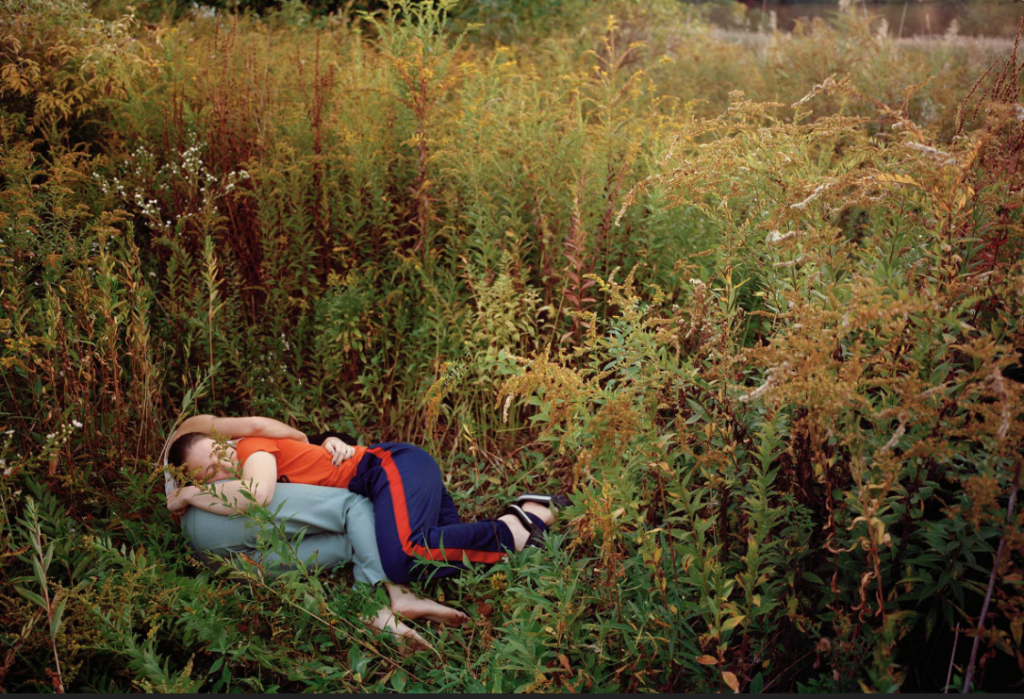
Within my response to Justine Kurland, I attempted to include similar aspects within this specific image inspired by her; such as the slight hint of red clothing, the background of nature and the physical close bond between the subjects, resembling strong relationships and intimacy.
Evaluation of my images compared to Justine Kurland:
The setting of nature is used in both mine and Kurland’s images, as they both take place in a natural, overgrown outdoor environment. I carried this out effectively as it allows my outcome to link to Kurland’s style of depicting her subjects in an untamed space. I also think I exhibited the composition of the image well, due to the subjects performing in an intimate manor which shows a clear connection between them. The main factor that differs my image from Kurland’s would be the overall tones within it. My image has been edited so that it has cooler tones being emphasised rather than warmer tones. This makes my image appear colder than Kurland’s, which I think overall changes the mood of the image and gives a slightly more melancholy effect. This is a drawback for me because I wanted this outcome to appear vibrant and reflect a happier mood, as the aim of this image is to allow the viewer to focus on the clear friendship between the subjects.
Ramona Wang
Ramona Jingru Wang uses her position in photography to reflect the themes of identity and community through her family and loved ones. Wang’s ethnicity plays a crucial role in her photographs, to create a strong narrative around the exploitations of Asian women in photography. Her heritage is a significant factor of the story behind her photographs, making her main aim through her work to delve into the connections between humans and the space around us, and also the impact that images can have on our perception of reality. She proposes her ideas into her work by photographing her loved ones building relationships with one another, and investigating how we as humans care for each other. Wang believes in discarding flat narratives of Asian models, as she is a model in art and photography herself. Therefore, her Family Album series was proposed in a way that implies blurring boundaries between private family life and public photography, where she captures intimate scenes at home focusing on the relationships of the people around her. I believe Ramona Wang’s approach to her work is important because it is a quiet refusal of the typical narratives shaped around women of her ethnicity. This ideology links to Kurland as the aim of both of their work is to challenge traditional stereotypes and ideologies surrounding categories of people, which relates to my work because I aiming to disregard typical expectations of young females and link it to my personal experiences with being a girl.

Ramona Magazinehttps://ramonamag.com › 2018/09 › artist-feature-ramo…
In an interview with ARTIST FEATURE, Wang stated:
‘I’ve always wondered why naked female bodies are always presented and seen in a sexual way, so I decided to see if I could create photos of my body that are honest and not for pleasing anyone.’
This statement by Wang reflects feminist opinions on the male gaze and the rights of women. It challenges the conventional portrayal of the female body in art and photography, as she questions why it is only looked at in a way of sexualisation to be consumed by men, and not in a way where it can be understood that female bodies can be photographed within personal expression through a camera. From the quote ‘honest and not for pleasing anyone’, I can gather that she is attempting to gain reclaim control over the male gaze, and wanting to shift perspectives on women as she emphasises honesty, which overall implies that she wants to be free from the idea of objectification.
Comparison of my images to Ramona Wang:
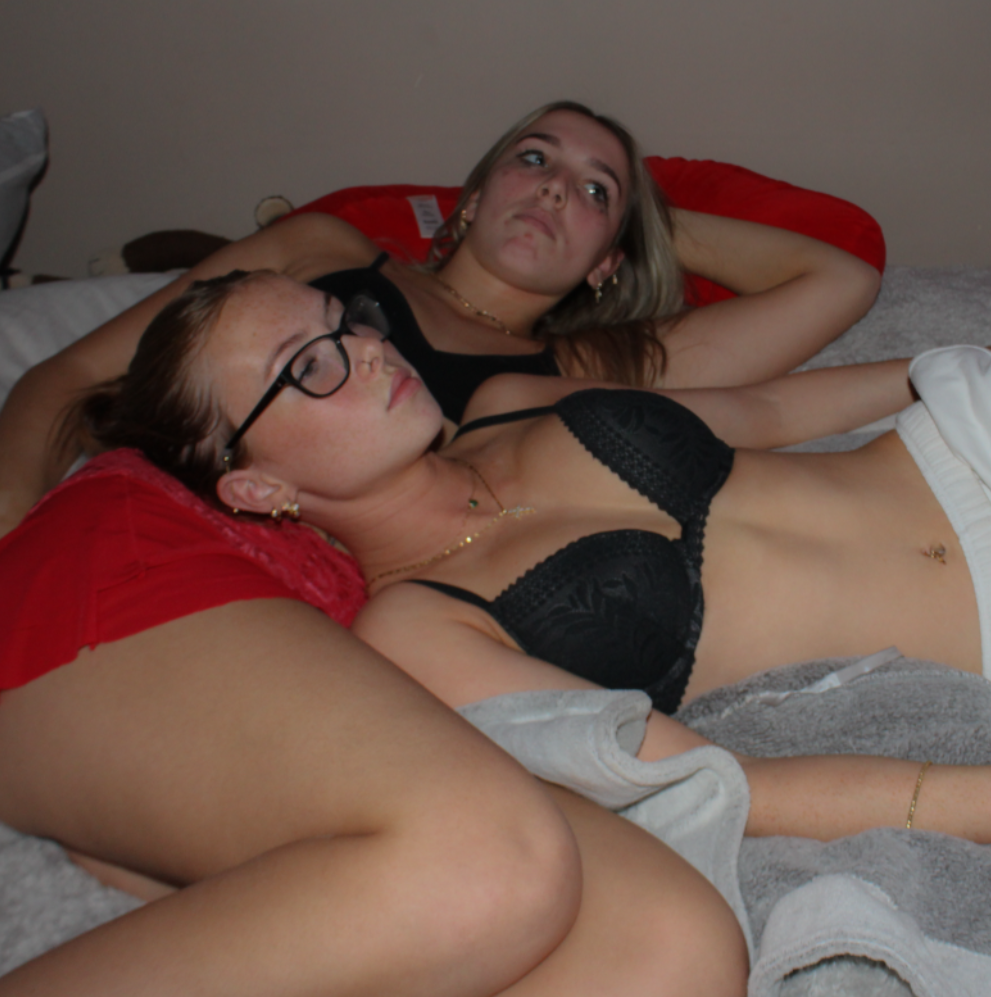
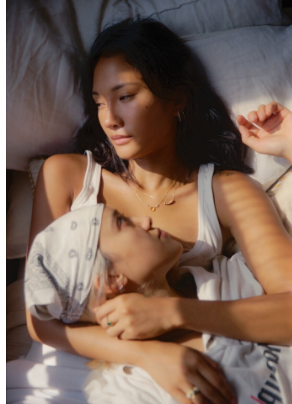
For my image comparison, I believe these two images share similarities within the subject matter, but differences within the overall tone and lighting. One thing that I think I executed well is the connection between my two subjects, as this links to what Wang produced and they both suggest a strong sense of togetherness, which is the aim I am trying to reflect. In both images, the subjects are also lying down, which implies a sense of realism as it gives the outcome a more casual effect, which allows it to look less staged. The frame and angle of my image is also very similar to the artists, as I have reinforced the focus on the facial expressions through the angle of the camera which is only focused on the subject expression. However, there are some clear differences between the two. My image was taken in the evening, meaning I had to use artificial lighting, whereas Wang’s image has been taken near a window in clear daylight as there is sunshine rays beaming on the subjects face. Another difference is the clothing on both of our subjects, Wang’s subjects are wearing softer clothing which gives her image a more relaxed and realistic effect, whereas my models are wearing minimal and harsh clothing, making it appear more dramatic.
Evaluation of my images compared to Ramona Wang:
To evaluate, I believe I executed similar outcomes to my artist inspiration by closely analysing the connection between models which I interpreted well as this was a main focus of mine to reflect on, as it links to my themes. I recreated this successfully in my image by using the same posing approach, where both my subjects are laying down with one lying on the other, and getting my subjects to perform in a way that presents a close relationship between them. However, I think Wang’s image evokes a deeper connection between her two subjects due to the model in the foreground looking up at the model behind her, which shows that Wang has carefully explored the theme of love and care, which I didn’t. Another drawback would be the difference in lighting as mine is artificial, which I think slightly shifts the perception of intimacy as it emphasises that the image is staged, whereas Wang’s image feels more natural.
Conclusion:
In conclusion, there are multiple parallels between both of my artist inspirations – Justine Kurland and Ramona Wang. They both explore themes of female representation and intimacy, linking to my themes on femininity and youth. Through carefully interpreting both of their photographic styles, in this project I was able to gain a strong sense of the conventional narratives on femininity and the way females are expressed through art and photography, through both landscapes and self-perceptions. The significant difference between my two artists is Kurland focuses on groups of young females in a wild and natural environment in which they explore a sense of freedom and escape, whereas Wang explores self representation with a more personal approach, challenging the traditional sexualisation of the female body. One of Wang’s main ideologies included throughout her work is the male gaze, as she questions how women are presented as well as perceived by men. Kurland does not explore the male gaze in her photographs, she explores a more crafted and opposing aesthetic through using nature and soft lighting to create a utopian world for young females. These two contrast heavily to one another, as Kurland’s approaches and compositions create a balance between innocence and real life documentary, yet Wang uses a more raw approach through self-representation which create a more unfiltered effect. Kurland executes her images in a way that highlights an idealised version of the world, through trying to challenge traditional domestic roles of women by depicting them as brave and free. On the other hand, Ramona Wang emphasises the reality of the female form, showing that she prioritises honesty.
I aimed to execute both of these ideologies throughout my five photoshoots for this project, tieing in both traditional stereotypes of young females as well as intimacy and resembling the close bonds that we share with one another. My overall objective is to create a seamless blend within my photo book, between the importance of personal identity through youth and the strong community between females. Drawing from Kurland’s depictions of her subjects, my photoshoots obtain a clear portrayal of freedom and female bonds as I focused on natural settings that evoke escape from traditional expectations. As Wang challenges the male gaze, I also incorporated aspects of this in my second and fourth photoshoot. I did this by using a more intimate approach within my subjects, to reinforce the idea of female objectification. By merging these two artists and their themes together, my project reflects a narrative where young females exist both collectively and personally, which overall challenges the way femininity is portrayed in art and photography.
Bibliography
Bengal, R. (2020) ‘The Jeremys’ in Girl Pictures. New York: Aperture.
Kurland, J. (2020) ‘Cherry Bomb’ in Girl Pictures. New York: Aperture.
Kurland, J. (July 14 2020). Justine Kurland Reflects on Her Photographs of Teenage Girl Runaways. New York: Aperture
https://aperture.org/featured/justine-kurland-girl-pictures/
ARTIST FEATURE: Ramona Jingru Wang
ARTS & CULTURE, Featureshttps://ramonamag.com/2018/09/artist-feature-ramona-jingru-wang/

Evie, I have made some minor corrections and used strikethrough text for deletion. Further comments are made in ( )
Overall, the essay reads well, but there is no evidence that you have read any of the key texts listed in your bibliography. Select relevant quotes from text that you can use to add further critical perspective to your own interpretation/ analysis. This is particularly needed in paragraph 1 where you are providing an historical and theoretical context to images of women in general. Comment on quotes used by agree/disagreeing.
In the introduction you make a valid point by saying that both artists work capture feminity well as they represent it from a female perspective. With reference to the photographic gaze, this is a case of female gaze which is opposite to the male gaze. Use your knowledge from Media studies and reference theory from Laura Mulvey’s key text, ‘ Visual Pleasure’ – see below
Mulvey, L. (1973) ‘Visual Pleasure and Narrative Cinema’ in Screen (1975)
https://www.columbia.edu/itc/architecture/ockman/pdfs/feminism/mulvey.pdf
For Pg 2 aon Kurland’s work make sure you read interviews, reviews about her work Girl Picture and references these sources here
Bengal, R. (2020) ‘The Jeremys’ in Girl Pictures. New York: Aperture.
https://hautlieucreative.co.uk/photo25al/wp-content/uploads/sites/71/2025/01/Bengal-R._The-Jeremys_Justine-Kurland.pdf
Kurland, J. (2020) ‘Cherry Bomb’ in Girl Pictures. New York: Aperture.
https://hautlieucreative.co.uk/photo25al/wp-content/uploads/sites/71/2025/01/Kurland-J._Cherry-Bomb.pdf
Kurland, J. (July 14 2020). Justine Kurland Reflects on Her Photographs of Teenage Girl Runaways. New York: Aperture
https://aperture.org/featured/justine-kurland-girl-pictures/
Ad these sources to your bibliography too
Evie, I’ve done a second reading up until paragraph on Justine Kurland and made some minor corrections, eg. re-worded sentence around Lacan’s / Irigaray’s concept of castration etc. So far it reads well and you just need to complete paragraph on Kurland, Wang and write a conclusion. A few others things to consider:
1. Quotes: only single quotation marks, no italics or bold.
2. Quotation and bibliography: consistency – make sure all in-text references and listings in bibliography are done using Harvard system – see below for guidelines, or ask me for help!
https://hautlieucreative.co.uk/photo16a2/wp-content/uploads/sites/2/2016/01/harvard-system-of-referencing.pdf
3. Illustrations: use images of artists work and your own as illustrations in between paragraphs. Make sure you caption them, ie. artist name, title, year etc.
4. Final proofread – check for misspellings, typos etc.